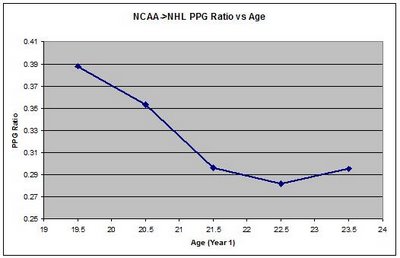Tuesday, January 29, 2008
Even-Strength Scoring Rate - before and after the lockout
I was looking at James Mirtle's post on how the new penalty/refereeing regime has changed the NHL, post-lockout, and I started wondering if we could see a difference in even-strength scoring rates. It stands to reason that teams score just as often on the power-play as they used to, but may be less inclined to clutch-and-grab at even-strength because of the increased risk of getting called for it.
Here are the results:
Year ESG/60 Mins
2000-01 5.24
2001-02 5.03
2002-03 5.03
2003-04 4.78
2004-05
2005-06 5.78
2006-07 5.44
2007-08 5.09
This isn't exactly correct; I'm including OT goals but not OT time. I'm also assuming that the average length of a power-play that ends in a PPG is one minute, and that all power-play opportunities where there's no PPG are two minutes. This is not correct, but NHL TOI data is terrible before 2002-03, so I pulled this from ESPN and made the approximations. I'll take a look at the NHL data again and see if I can do a bit better.
At any rate, even-strength goal-scoring was dropping very precipitously prior to the lockout. The new rules completely changed everything - but the league has quickly come back to where it was just before the lockout. On top of that, as James' post shows, the rate at which penaties are awarded has dropped too. Everything's back to where it was in 2002-03 - but we have a lot more hooking calls. So even though scoring rates are no different, clutching-and-grabbing is much more likely to result in a penalty - which potentially allows for more skilled play, though I'm not convinced.
Here are the results:
Year ESG/60 Mins
2000-01 5.24
2001-02 5.03
2002-03 5.03
2003-04 4.78
2004-05
2005-06 5.78
2006-07 5.44
2007-08 5.09
This isn't exactly correct; I'm including OT goals but not OT time. I'm also assuming that the average length of a power-play that ends in a PPG is one minute, and that all power-play opportunities where there's no PPG are two minutes. This is not correct, but NHL TOI data is terrible before 2002-03, so I pulled this from ESPN and made the approximations. I'll take a look at the NHL data again and see if I can do a bit better.
At any rate, even-strength goal-scoring was dropping very precipitously prior to the lockout. The new rules completely changed everything - but the league has quickly come back to where it was just before the lockout. On top of that, as James' post shows, the rate at which penaties are awarded has dropped too. Everything's back to where it was in 2002-03 - but we have a lot more hooking calls. So even though scoring rates are no different, clutching-and-grabbing is much more likely to result in a penalty - which potentially allows for more skilled play, though I'm not convinced.
Labels: penalties
Tuesday, January 1, 2008
Kyle Okposo and Projecting the NCAA to the NHL
Kyle Okposo made a few headlines this week: after the World Junior Championships are over, he's quitting the University of Minnesota and joining the New York Islanders. He was drafted 7th overall in 2006, which puts him a bit behind the curve in jumping to the NHL: he's the only player in the top 15 who hasn't played professional hockey. His former teammates Phil Kessel and Erik Johnson are playing regularly in the NHL.
So the question is, if the Islanders keep him in the NHL, what can we expect from Okposo for his next 40 games? This chart shows the ratio of NHL points-per-game to NCAA points-per-game for all players who've jumped from college to the NHL since 1979:
So 50% of players retained 29% of their scoring in the NHL; just 10% retained 48% or more. Okposo has had a pedestrian 2007 NCAA season (11 points in 18 games), and if we combine that with 2006 (40 points in 40 games), his middle 50% scoring range amounts to 7-14 points in the second half of the 2007-08 season.
That seems a little conservative, and we should take into account that Okposo isn't 20 years old yet. This chart shows the difference in PPG ratios by age:

So we were probably 25% too pessimistic with our projection. Okposo is a good bet to pick up between 10 and 18 points in his next 40 games. That's low enough that the Islanders might just assign him to their AHL affiliate, and we won't see Okposo until next year.
So the question is, if the Islanders keep him in the NHL, what can we expect from Okposo for his next 40 games? This chart shows the ratio of NHL points-per-game to NCAA points-per-game for all players who've jumped from college to the NHL since 1979:
| 10% | 25% | 50% | 75% | 90% | |
| NCAA | 0.15 | 0.21 | 0.29 | 0.39 | 0.48 |
So 50% of players retained 29% of their scoring in the NHL; just 10% retained 48% or more. Okposo has had a pedestrian 2007 NCAA season (11 points in 18 games), and if we combine that with 2006 (40 points in 40 games), his middle 50% scoring range amounts to 7-14 points in the second half of the 2007-08 season.
That seems a little conservative, and we should take into account that Okposo isn't 20 years old yet. This chart shows the difference in PPG ratios by age:

So we were probably 25% too pessimistic with our projection. Okposo is a good bet to pick up between 10 and 18 points in his next 40 games. That's low enough that the Islanders might just assign him to their AHL affiliate, and we won't see Okposo until next year.
Labels: Equivalencies, NCAA, Projections
Subscribe to Posts [Atom]
